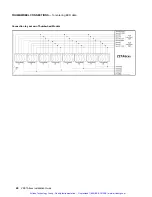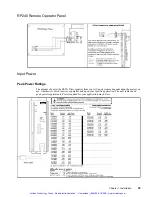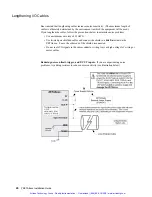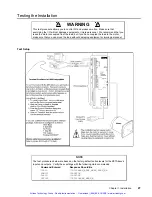
38
ζ
ZETA6xxx Installation Guide
6. Turn On Active Damping
Turn the active damping rotary switch to position 1. This turns on active damping at its lowest
setting, and disables anti-resonance.
You can change the rotary switch setting "on the fly." You do not have to cycle power each time you
change the switch setting. During a repetitive move, you can change the switch setting while the
move is in progress. This allows you to immediately compare two different switch settings.
7. Make a Move With Active Damping Turned On
Compare the sound and vibration to the baseline move.
8. Increase the Switch Setting
Turn the rotary switch to position 2 (unless position 1 is your calculated maximum). Make the move
again. Compare the sound and vibration to the levels obtained at the lower setting.
9. Find the Ideal Switch Setting
Continue to increase the switch setting by single increments. Each time you increase the setting,
compare the results with the lower setting. Increase the setting until you obtain optimum results for
your move. This will be the setting that yields the lowest audible noise and smoothest motor
operation.
Never exceed your maximum switch setting. For many applications, you will not need to go as high
as the maximum setting. If you do not see perceptible improvement from one switch setting to the
next, use the lower switch setting.
Higher switch settings will result in higher dynamic motor current during transients, which can cause
increased motor heating. Higher curent also increases motor torque, resulting in sharper accelerations
than can jerk or stress the mechanics in your system. If you ramp up through each intermediate switch
position, you can evaluate the effects on your mechanics as you gradually increase damping.
Configuring Electronic Viscosity (EV)
Before You Start
• If you configured active damping (see procedure above), leave the setting set at the value
you chose. You do not need to disable active damping while you configure EV.
• Couple the motor to the load (see pages 33-35 for details). EV must be configured under
the normal mechanical operating conditions for your application.
• Record the
DELVIS
command setting. The procedure below helps you identify the
appropriate set-up command (
DELVIS
) that will prepare your system for optimized
performance.
DELVIS
is not saved in non-volatile memory. Therefore, you should write
down this command as you qualify it in this procedure, then place it in a program. Page 41
shows an example of how to place
DELVIS
in a set-up (
STARTP
) program (a set-up program
executes user-specified commands that establish power-up operational defaults for your
application).
Step 1
Verify correct motor-to-ZETA6xxx matching. See Matching the Motor to the ZETA6xxx
on page 30. To be fully effective, the active damping circuit requires proper matching. If you
are replacing a component (new ZETA6xxx or motor) in an existing application, you must
rematch your system.
Artisan Technology Group - Quality Instrumentation ... Guaranteed | (888) 88-SOURCE | www.artisantg.com






























